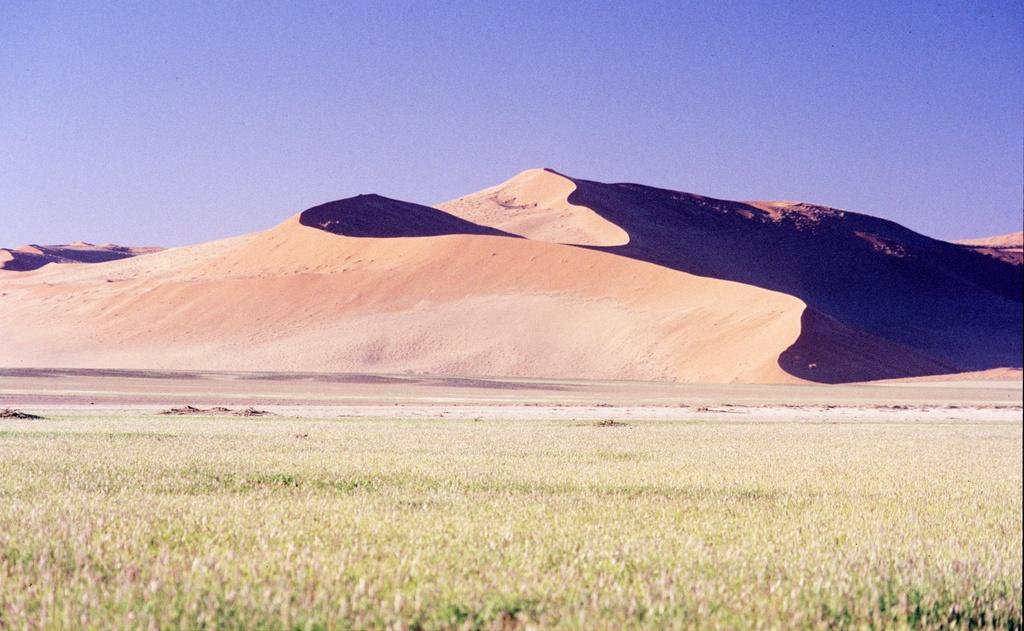

Land on Earth is an inherently finite resource — but demand for it is always increasing. There are 50.1 million square miles of land area worldwide, and only some of it is habitable. Meanwhile, according to the World Bank, there are nearly 8 billion people on the planet, up from just 3 billion in 1960. Over the same period, global population density climbed from 74 people per square mile to 159.
Demand for land will likely only continue to grow in the foreseeable future. For any geography to maintain its population size, the average fertility rate should be around 2.1 children per woman. Currently, however, women are having an average of 2.3 children in their lifetime, meaning population growth and a more crowded world are virtual certainties in the coming years. (Here is a look at the countries with the highest birth rates.)
Of course, the global population is not spread evenly across the world’s 195 countries. And due to variations in geographic area and population size at the country level, some parts of the world are far less densely populated than others.
Using 2022 data from the World Bank, 24/7 Wall St. identified the world’s 30 most sparsely populated countries. Supplemental data on population distribution, gross domestic product, and total fertility rates — or the average number of children women have in their lifetime — are also from the World Bank and are for the latest available year.
The countries on this list range in population density, from about 50 people per square mile, to fewer than 10. Not surprisingly, some of these countries are among the largest in the world by land area, like Australia, Canada, and Russia.
Despite spanning hundreds of thousands, or even millions of square miles, many of these countries are still home to large, densely populated cities. In all but six of the 30 countries on this list, over half of the population resides in an urban area. (Here is a look at the most densely populated countries in the world.)
In many of these places, high urbanization rates are partially attributable to vast expanses of land area that are either uninhabitable or undesirable. In both Canada and Russia, for example, large swathes of territory are subject to especially long and harsh winters. In other countries on this list, like Australia, Libya, Mali, and Mauritania, much of the landscape is claimed by desert.
Why It Matters

Population density can have a number of implications for governments, economies, and environments. Overpopulation and sprawl can put a strain on natural resources, negatively impact biodiversity, and create infrastructure challenges. In less densely populated areas, fewer people can mean a smaller tax base and limited incentive for business development. Residents can also struggle with access to essential services.
30. Uruguay
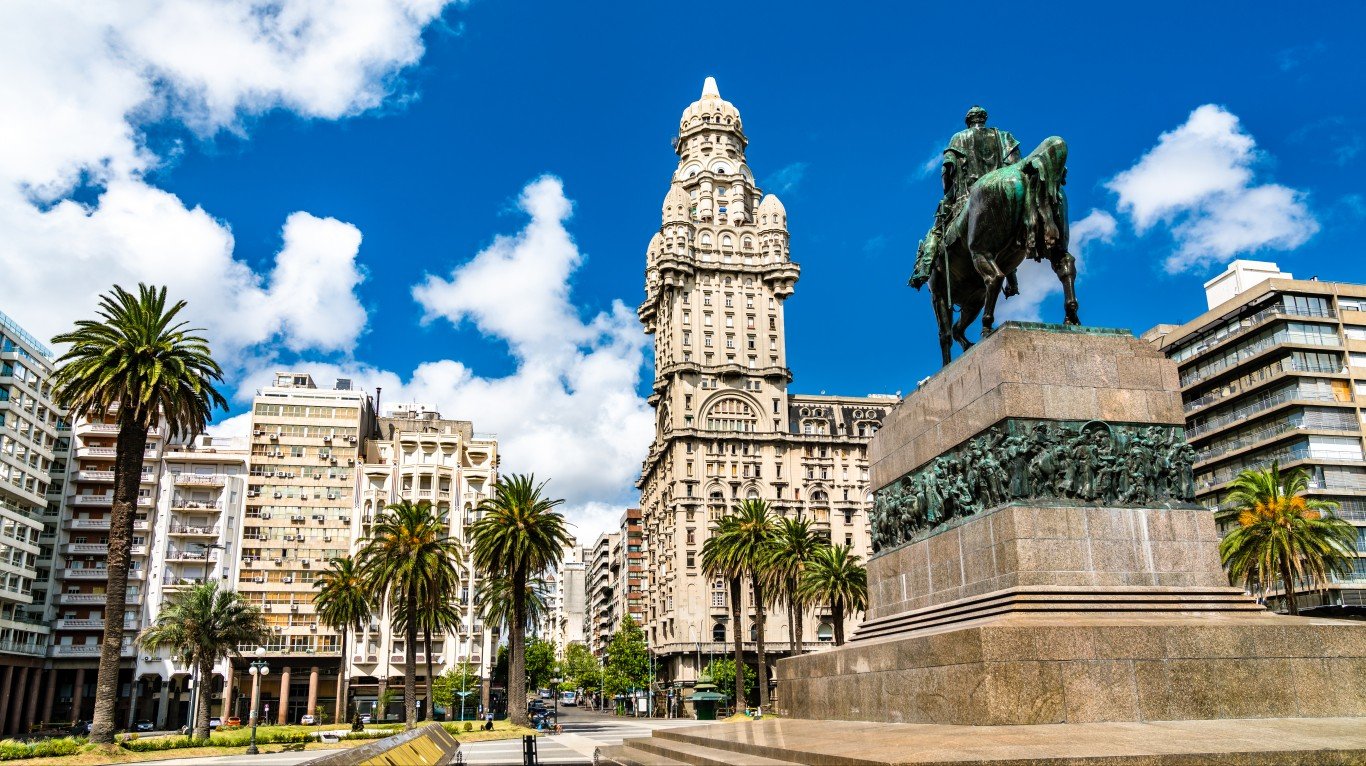
- Population density in 2022: 51 people per sq. mile
- Total population: 3,422,794 (130th most of 195 countries)
- Total land area: 67,576 sq. miles (89th largest of 195 countries)
- Population by community type: 95.7% urban; 4.3% rural
- Gross domestic product in 2022: $71.2 billion ($20,795 per capita)
- Total fertility rate in 2021: Avg. of 1.5 children per woman over lifetime
29. New Zealand

- Population density in 2022: 50 people per sq. mile
- Total population: 5,124,100 (122nd most of 195 countries)
- Total land area: 101,665 sq. miles (74th largest of 195 countries)
- Population by community type: 86.9% urban; 13.1% rural
- Gross domestic product in 2022: $248.1 billion ($48,419 per capita)
- Total fertility rate in 2021: Avg. of 1.6 children per woman over lifetime
28. Algeria

- Population density in 2022: 49 people per sq. mile
- Total population: 44,903,225 (34th most of 195 countries)
- Total land area: 919,595 sq. miles (10th largest of 195 countries)
- Population by community type: 74.8% urban; 25.2% rural
- Gross domestic product in 2022: $195.0 billion ($4,343 per capita)
- Total fertility rate in 2021: Avg. of 2.9 children per woman over lifetime
27. Mali
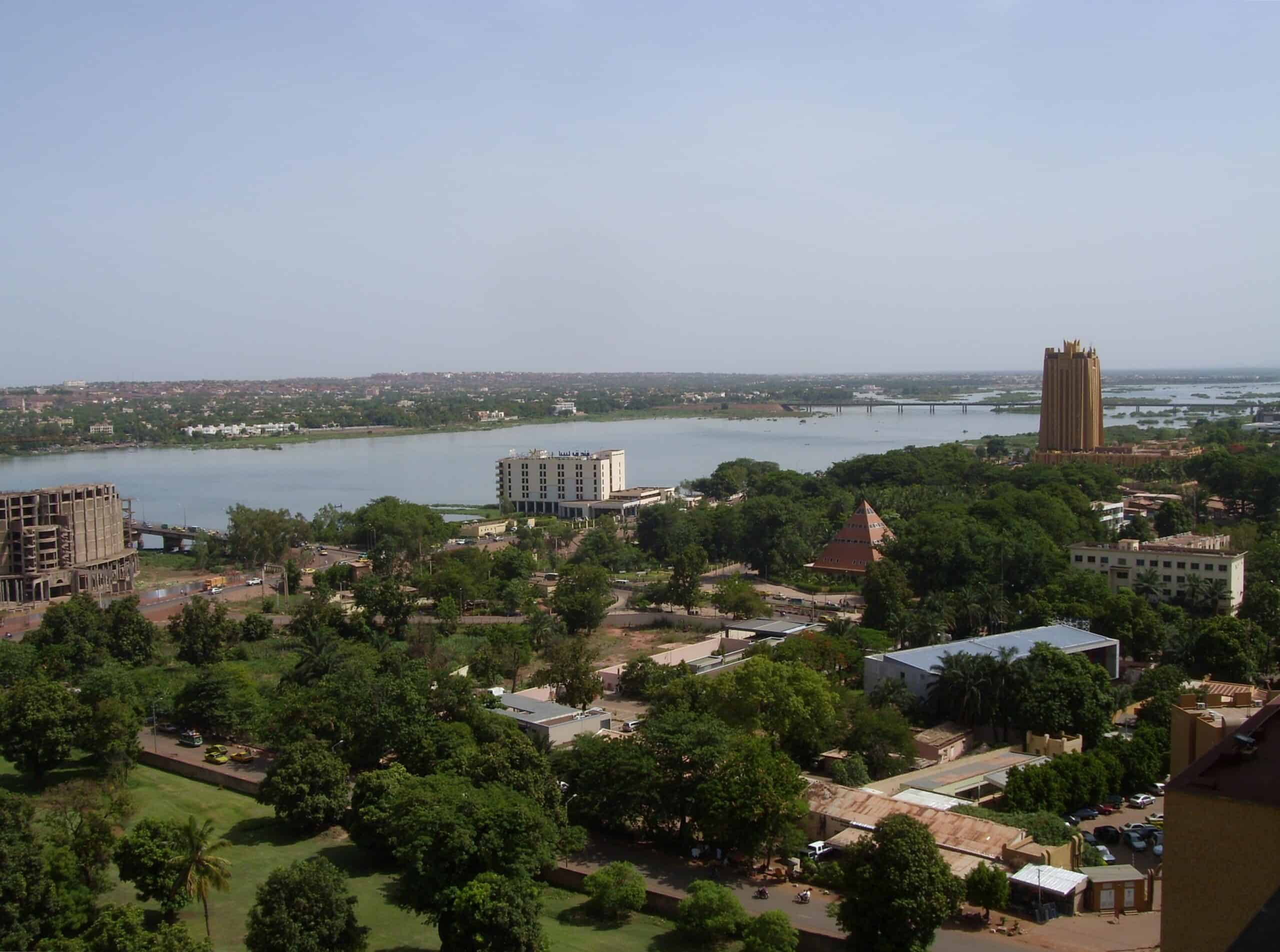
- Population density in 2022: 48 people per sq. mile
- Total population: 22,593,590 (58th most of 195 countries)
- Total land area: 471,118 sq. miles (23rd largest of 195 countries)
- Population by community type: 45.4% urban; 54.6% rural
- Gross domestic product in 2022: $18.8 billion ($833 per capita)
- Total fertility rate in 2021: Avg. of 6.0 children per woman over lifetime
26. Finland

- Population density in 2022: 47 people per sq. mile
- Total population: 5,556,106 (115th most of 195 countries)
- Total land area: 117,355 sq. miles (70th largest of 195 countries)
- Population by community type: 85.7% urban; 14.3% rural
- Gross domestic product in 2022: $282.6 billion ($50,872 per capita)
- Total fertility rate in 2021: Avg. of 1.5 children per woman over lifetime
25. Belize
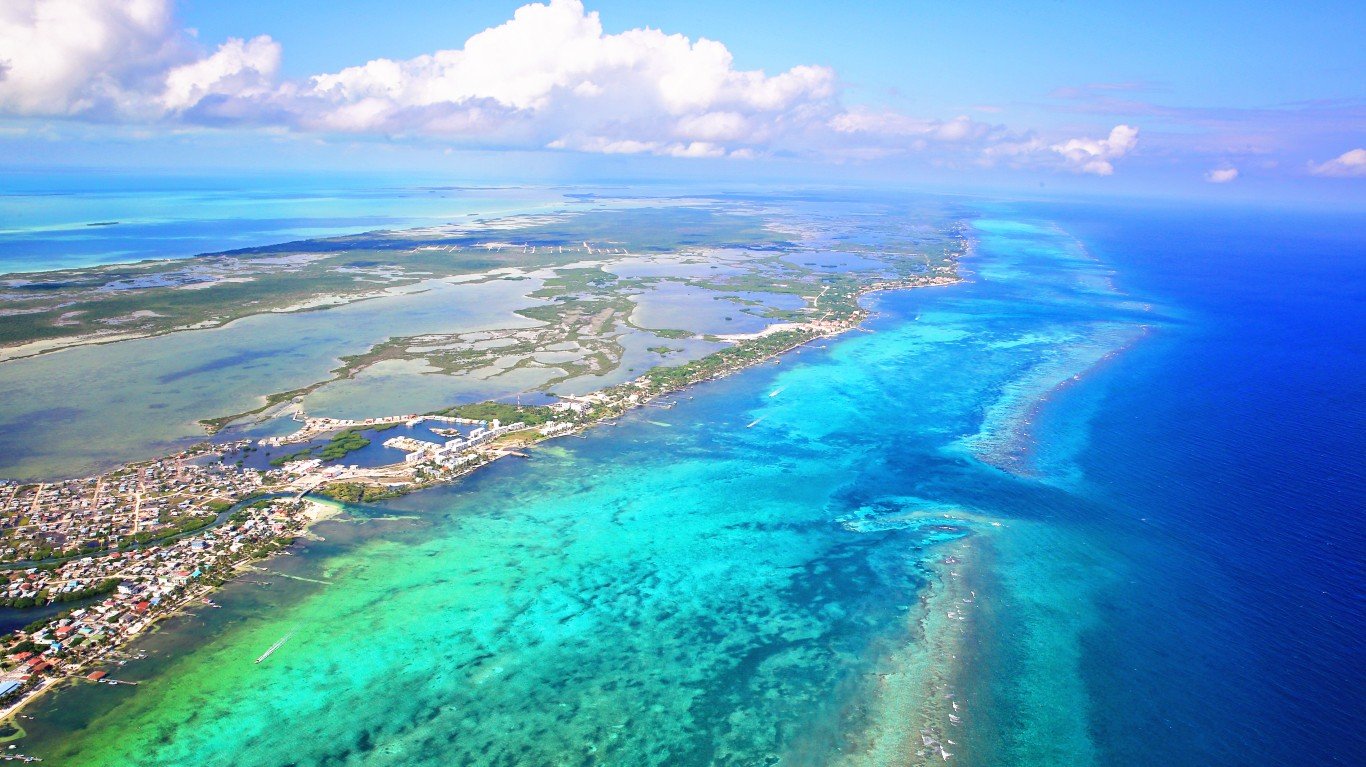
- Population density in 2022: 46 people per sq. mile
- Total population: 405,272 (171st most of 195 countries)
- Total land area: 8,807 sq. miles (147th largest of 195 countries)
- Population by community type: 46.4% urban; 53.6% rural
- Gross domestic product in 2022: $2.8 billion ($6,984 per capita)
- Total fertility rate in 2021: Avg. of 2.0 children per woman over lifetime
24. Congo, Rep.
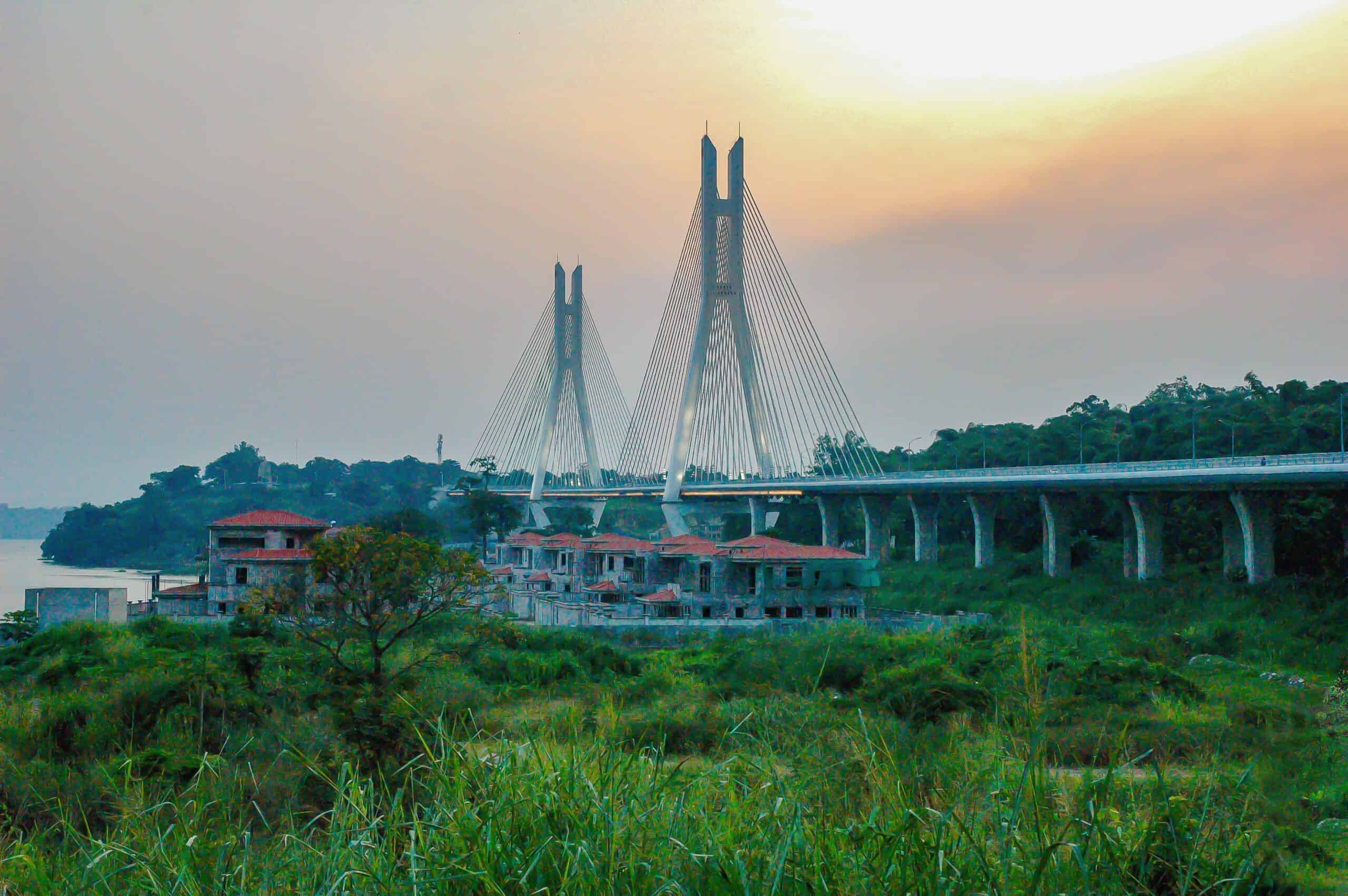
- Population density in 2022: 45 people per sq. mile
- Total population: 5,970,424 (111th most of 195 countries)
- Total land area: 131,854 sq. miles (64th largest of 195 countries)
- Population by community type: 68.7% urban; 31.3% rural
- Gross domestic product in 2022: $15.8 billion ($2,649 per capita)
- Total fertility rate in 2021: Avg. of 4.2 children per woman over lifetime
23. South Sudan
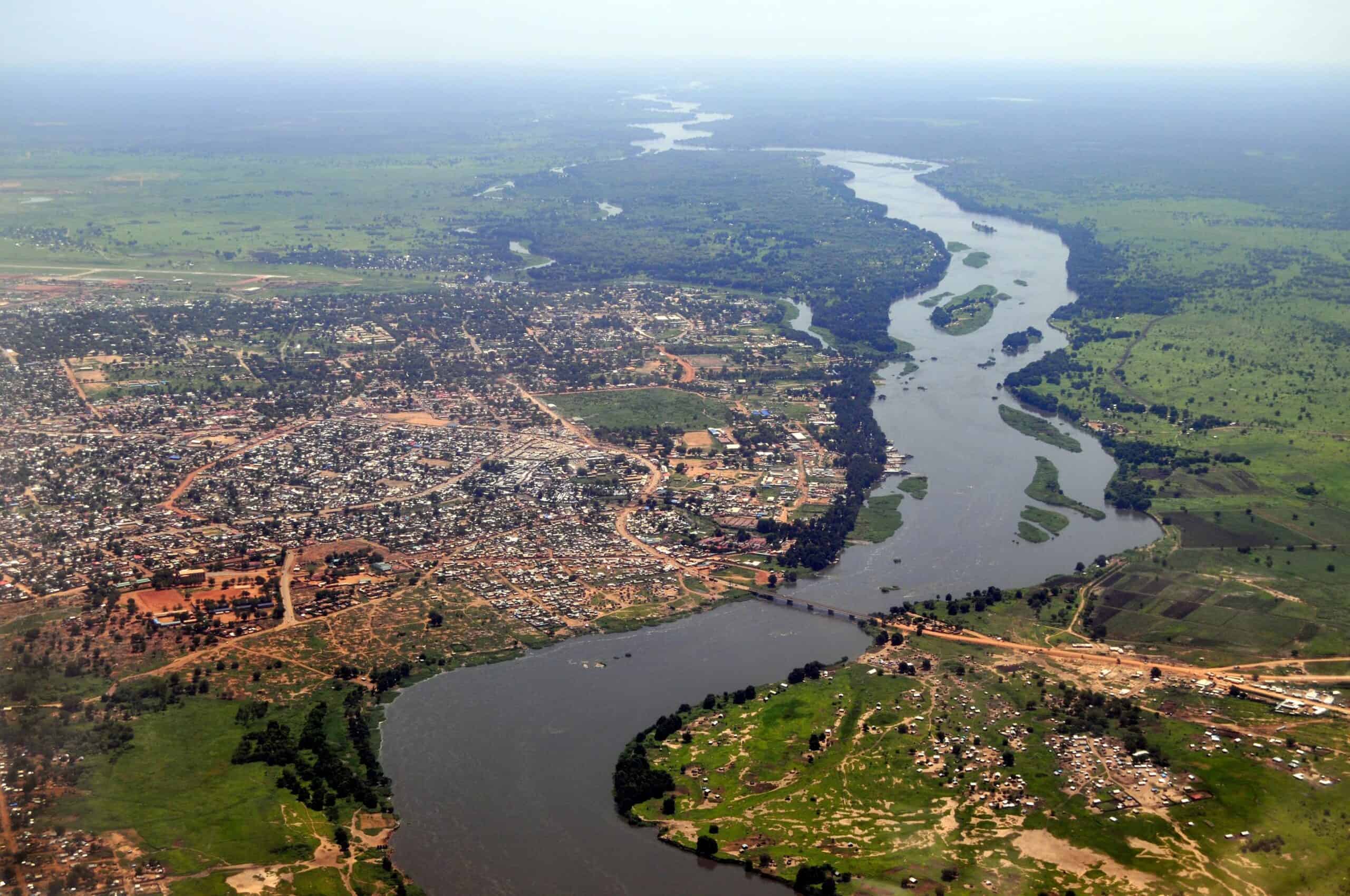
- Population density in 2022: 45 people per sq. mile
- Total population: 10,913,164 (85th most of 195 countries)
- Total land area: 243,990 sq. miles (41st largest of 195 countries)
- Population by community type: 20.8% urban; 79.2% rural
- Gross domestic product in 2015: $12.0 billion ($1,072 per capita)
- Total fertility rate in 2021: Avg. of 4.5 children per woman over lifetime
22. Paraguay
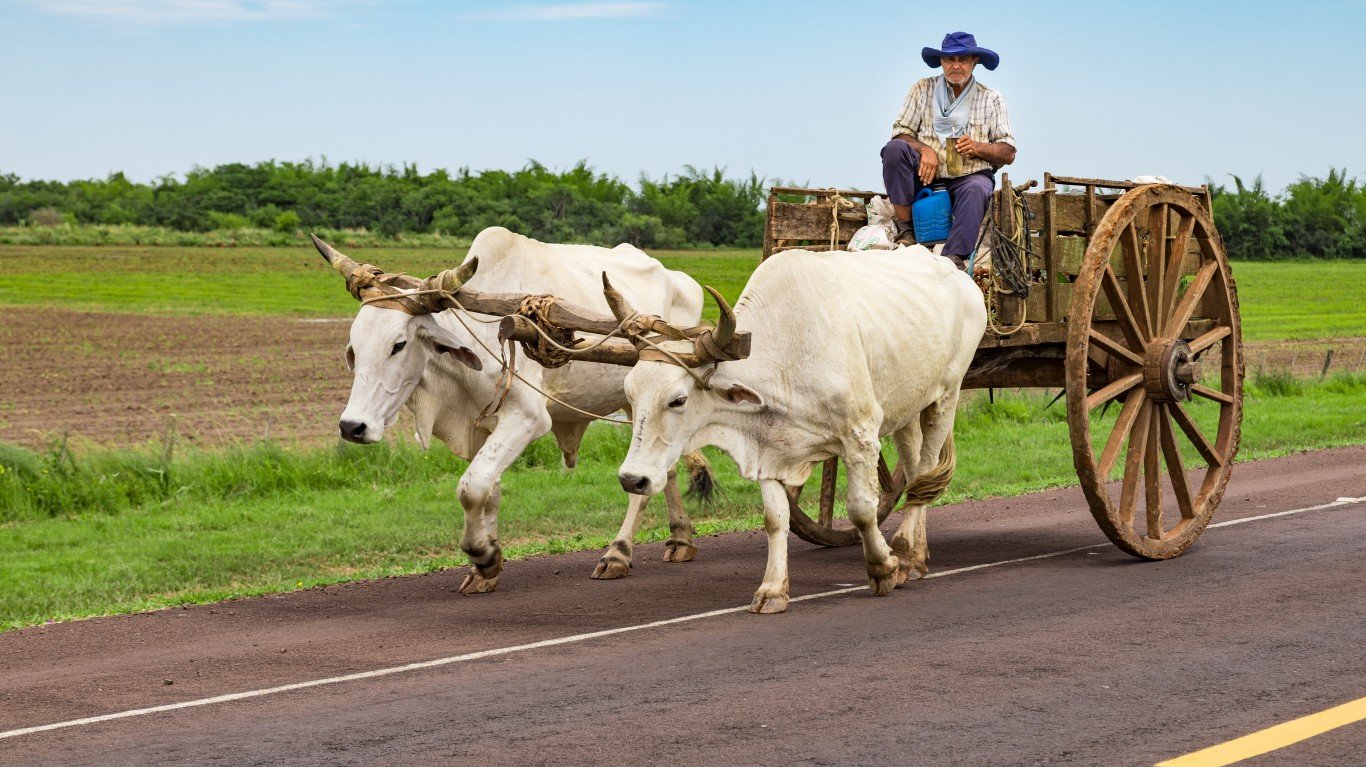
- Population density in 2022: 44 people per sq. mile
- Total population: 6,780,744 (106th most of 195 countries)
- Total land area: 153,398 sq. miles (59th largest of 195 countries)
- Population by community type: 62.8% urban; 37.2% rural
- Gross domestic product in 2022: $41.7 billion ($6,153 per capita)
- Total fertility rate in 2021: Avg. of 2.5 children per woman over lifetime
21. Saudi Arabia
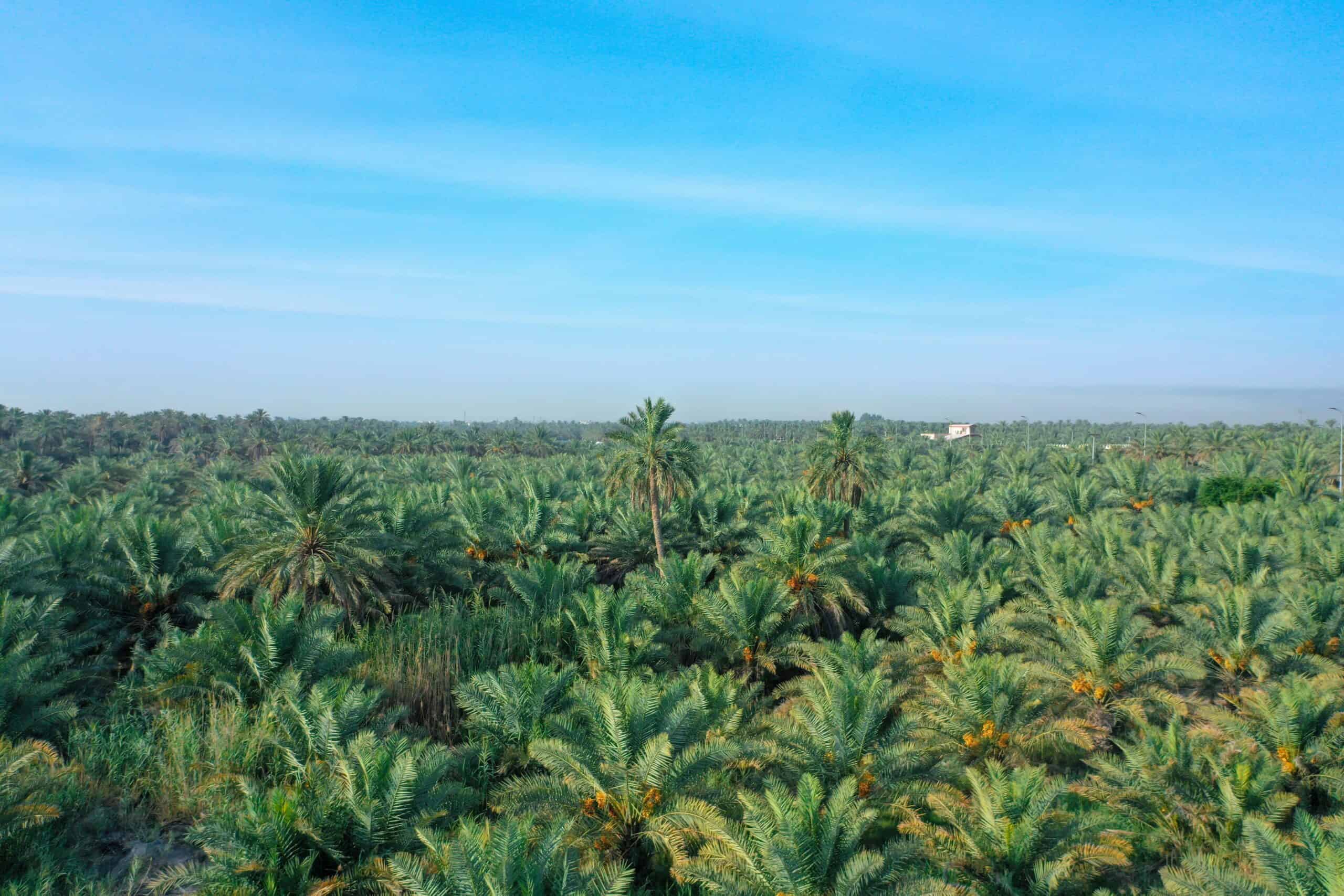
- Population density in 2022: 44 people per sq. mile
- Total population: 36,408,820 (41st most of 195 countries)
- Total land area: 830,000 sq. miles (12th largest of 195 countries)
- Population by community type: 84.7% urban; 15.3% rural
- Gross domestic product in 2022: $1.1 trillion ($30,448 per capita)
- Total fertility rate in 2021: Avg. of 2.4 children per woman over lifetime
20. Argentina
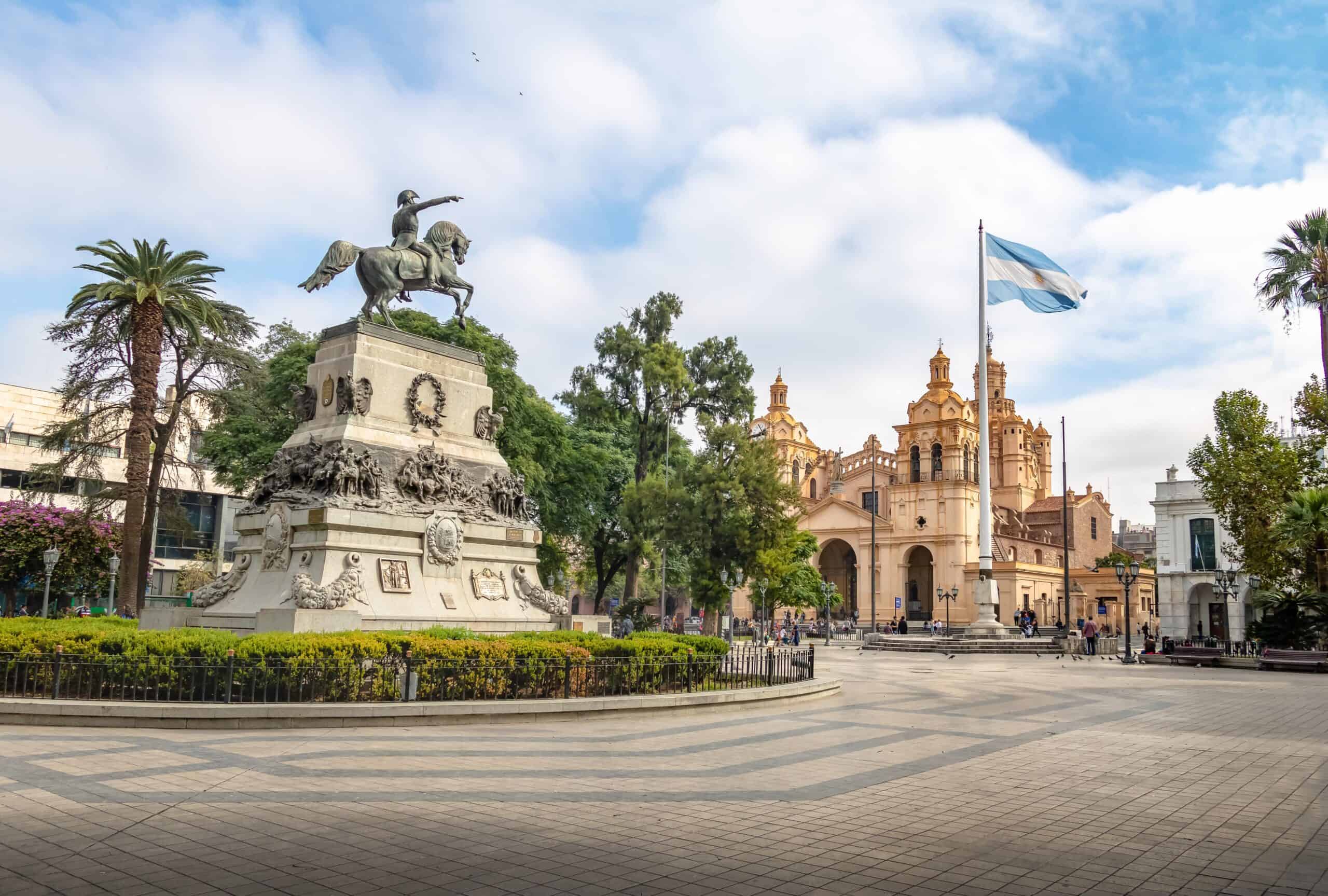
- Population density in 2022: 44 people per sq. mile
- Total population: 46,234,830 (33rd most of 195 countries)
- Total land area: 1,056,642 sq. miles (8th largest of 195 countries)
- Population by community type: 92.3% urban; 7.7% rural
- Gross domestic product in 2022: $631.1 billion ($13,651 per capita)
- Total fertility rate in 2021: Avg. of 1.9 children per woman over lifetime
19. Norway
- Population density in 2022: 39 people per sq. mile
- Total population: 5,457,127 (117th most of 195 countries)
- Total land area: 140,645 sq. miles (62nd largest of 195 countries)
- Population by community type: 83.7% urban; 16.3% rural
- Gross domestic product in 2022: $593.3 billion ($108,729 per capita)
- Total fertility rate in 2021: Avg. of 1.6 children per woman over lifetime
18. Oman

- Population density in 2022: 38 people per sq. mile
- Total population: 4,576,298 (124th most of 195 countries)
- Total land area: 119,499 sq. miles (68th largest of 195 countries)
- Population by community type: 87.8% urban; 12.3% rural
- Gross domestic product in 2022: $114.7 billion ($25,057 per capita)
- Total fertility rate in 2021: Avg. of 2.6 children per woman over lifetime
17. Chad

- Population density in 2022: 36 people per sq. mile
- Total population: 17,723,315 (67th most of 195 countries)
- Total land area: 486,180 sq. miles (21st largest of 195 countries)
- Population by community type: 24.1% urban; 75.9% rural
- Gross domestic product in 2022: $12.7 billion ($717 per capita)
- Total fertility rate in 2021: Avg. of 6.3 children per woman over lifetime
16. Turkmenistan
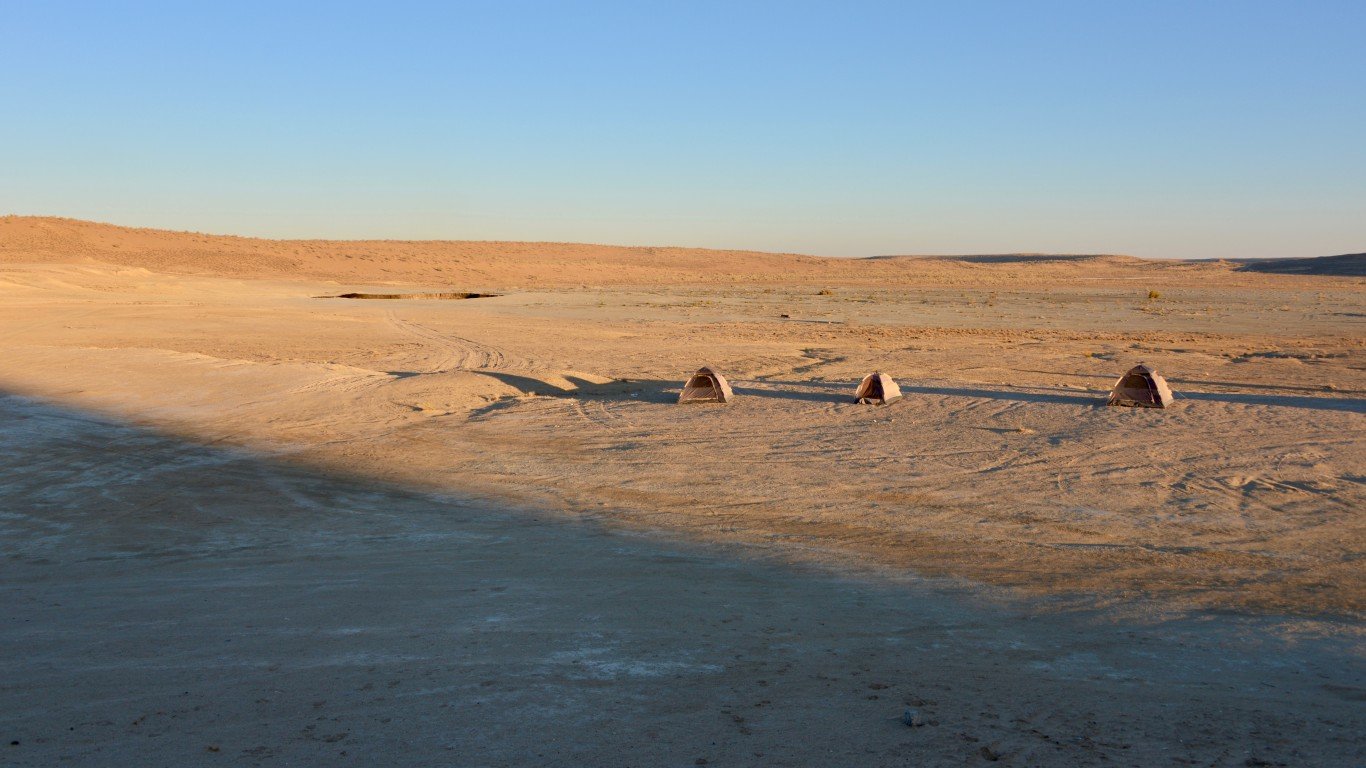
- Population density in 2022: 35 people per sq. mile
- Total population: 6,430,770 (109th most of 195 countries)
- Total land area: 181,441 sq. miles (53rd largest of 195 countries)
- Population by community type: 53.5% urban; 46.5% rural
- Gross domestic product in 2022: $56.5 billion ($8,793 per capita)
- Total fertility rate in 2021: Avg. of 2.7 children per woman over lifetime
15. Bolivia
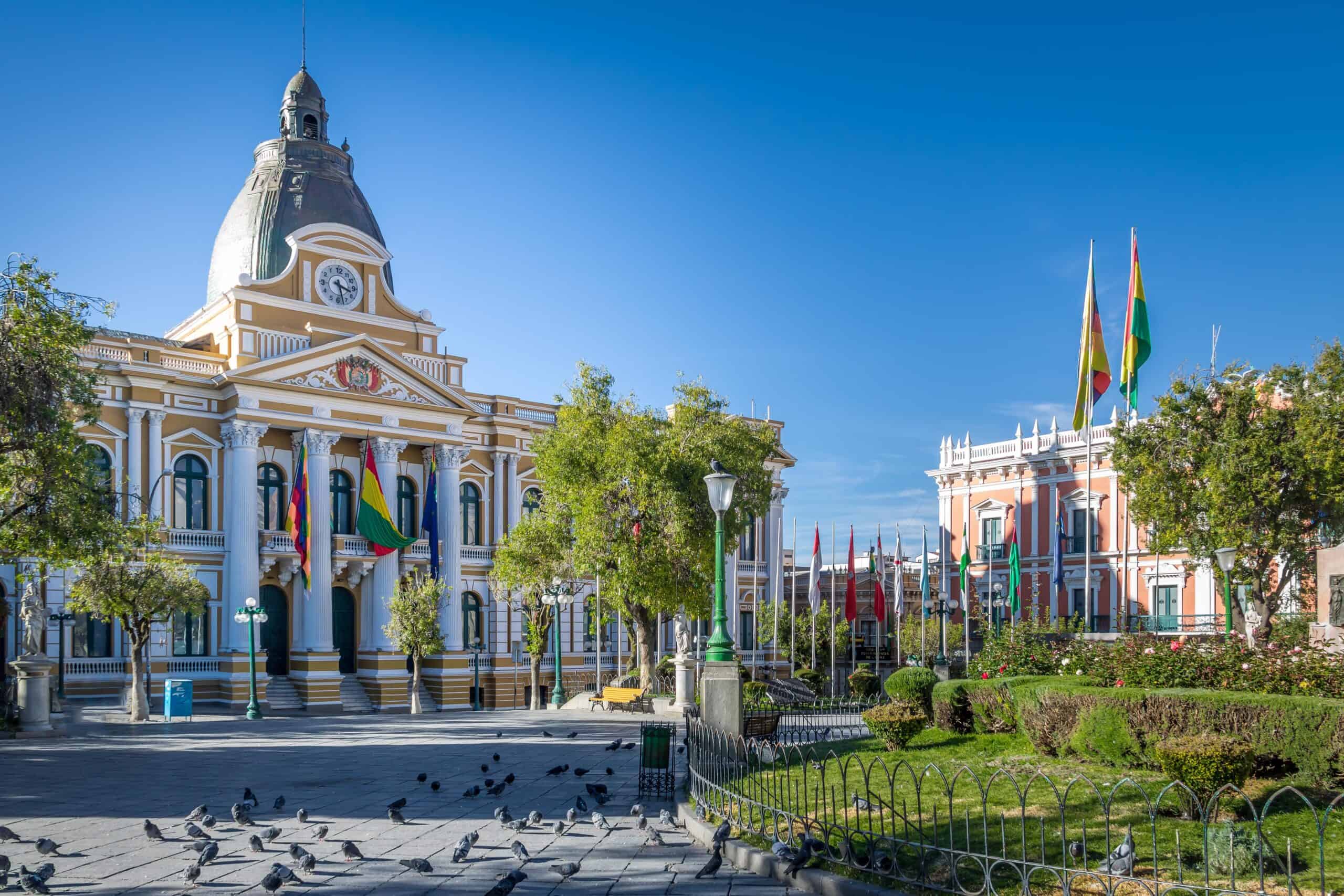
- Population density in 2022: 29 people per sq. mile
- Total population: 12,224,110 (79th most of 195 countries)
- Total land area: 418,264 sq. miles (27th largest of 195 countries)
- Population by community type: 70.8% urban; 29.2% rural
- Gross domestic product in 2022: $44.0 billion ($3,600 per capita)
- Total fertility rate in 2021: Avg. of 2.6 children per woman over lifetime
14. Gabon
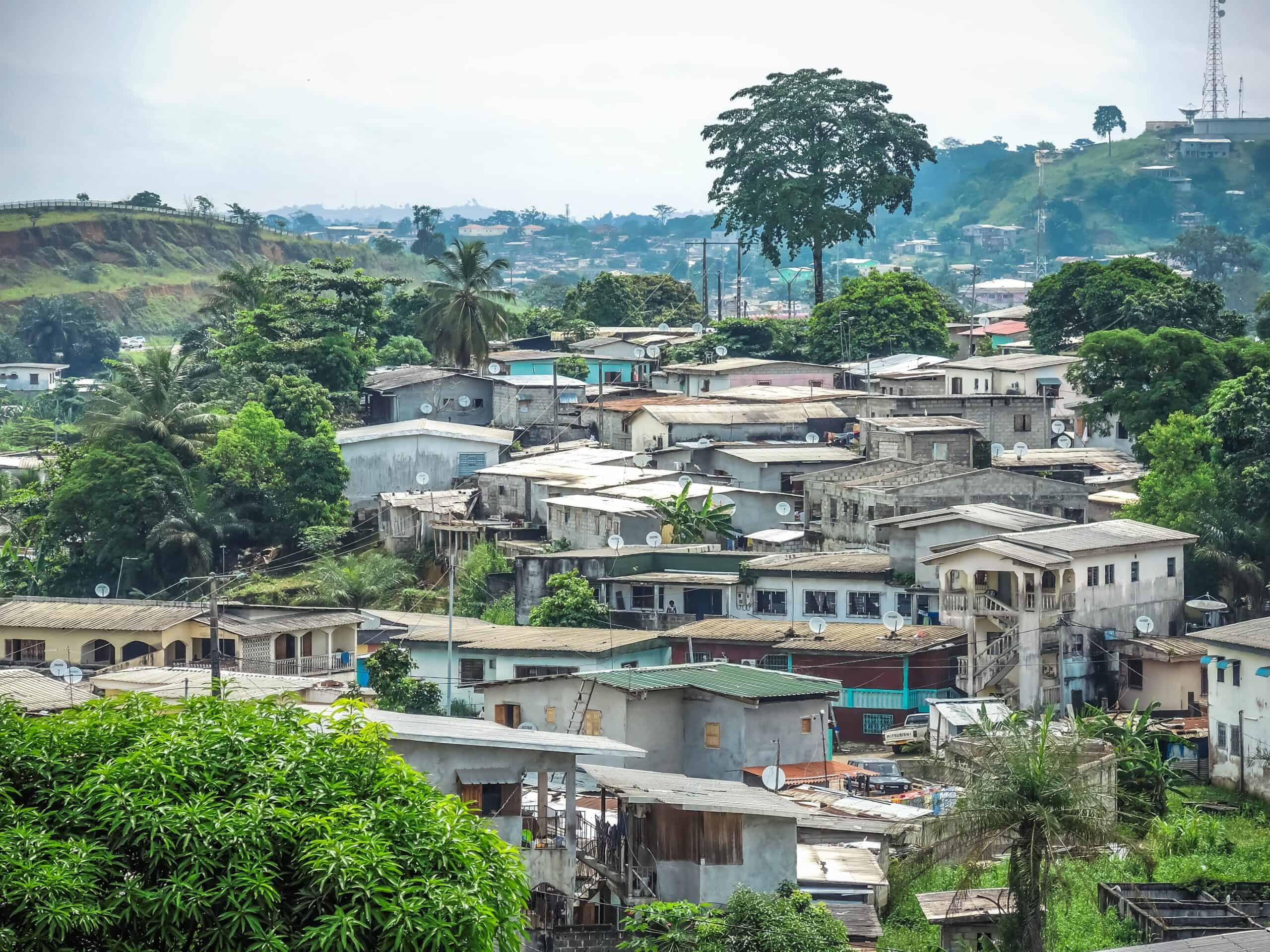
- Population density in 2022: 24 people per sq. mile
- Total population: 2,388,992 (142nd most of 195 countries)
- Total land area: 99,487 sq. miles (75th largest of 195 countries)
- Population by community type: 90.7% urban; 9.3% rural
- Gross domestic product in 2022: $21.1 billion ($8,820 per capita)
- Total fertility rate in 2021: Avg. of 3.5 children per woman over lifetime
13. Central African Republic
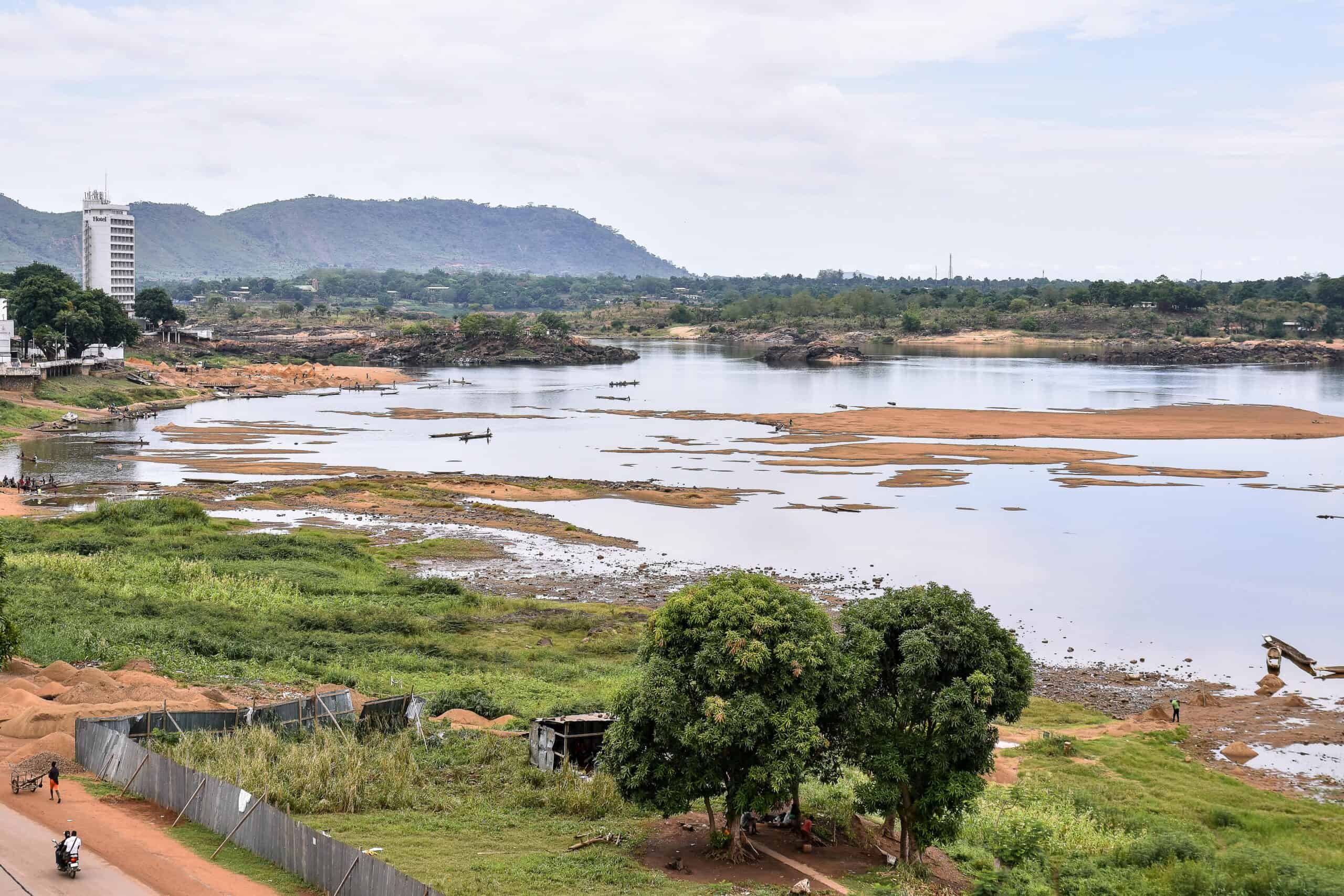
- Population density in 2022: 23 people per sq. mile
- Total population: 5,579,144 (114th most of 195 countries)
- Total land area: 240,534 sq. miles (43rd largest of 195 countries)
- Population by community type: 43.1% urban; 56.9% rural
- Gross domestic product in 2022: $2.4 billion ($427 per capita)
- Total fertility rate in 2021: Avg. of 6.0 children per woman over lifetime
12. Russia
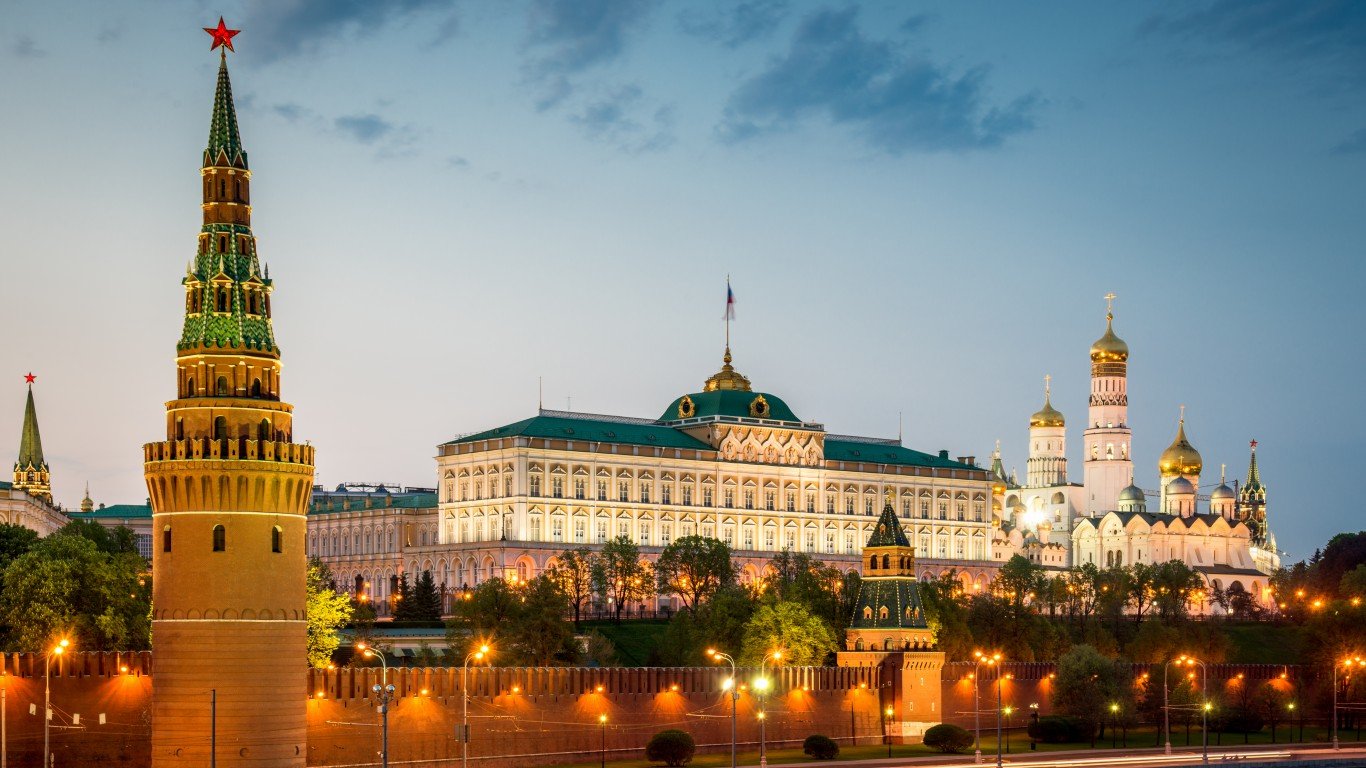
- Population density in 2022: 23 people per sq. mile
- Total population: 144,236,933 (9th most of 195 countries)
- Total land area: 6,323,145 sq. miles (the largest of 195 countries)
- Population by community type: 75.1% urban; 24.9% rural
- Gross domestic product in 2022: $2.2 trillion ($15,271 per capita)
- Total fertility rate in 2021: Avg. of 1.5 children per woman over lifetime
11. Kazakhstan
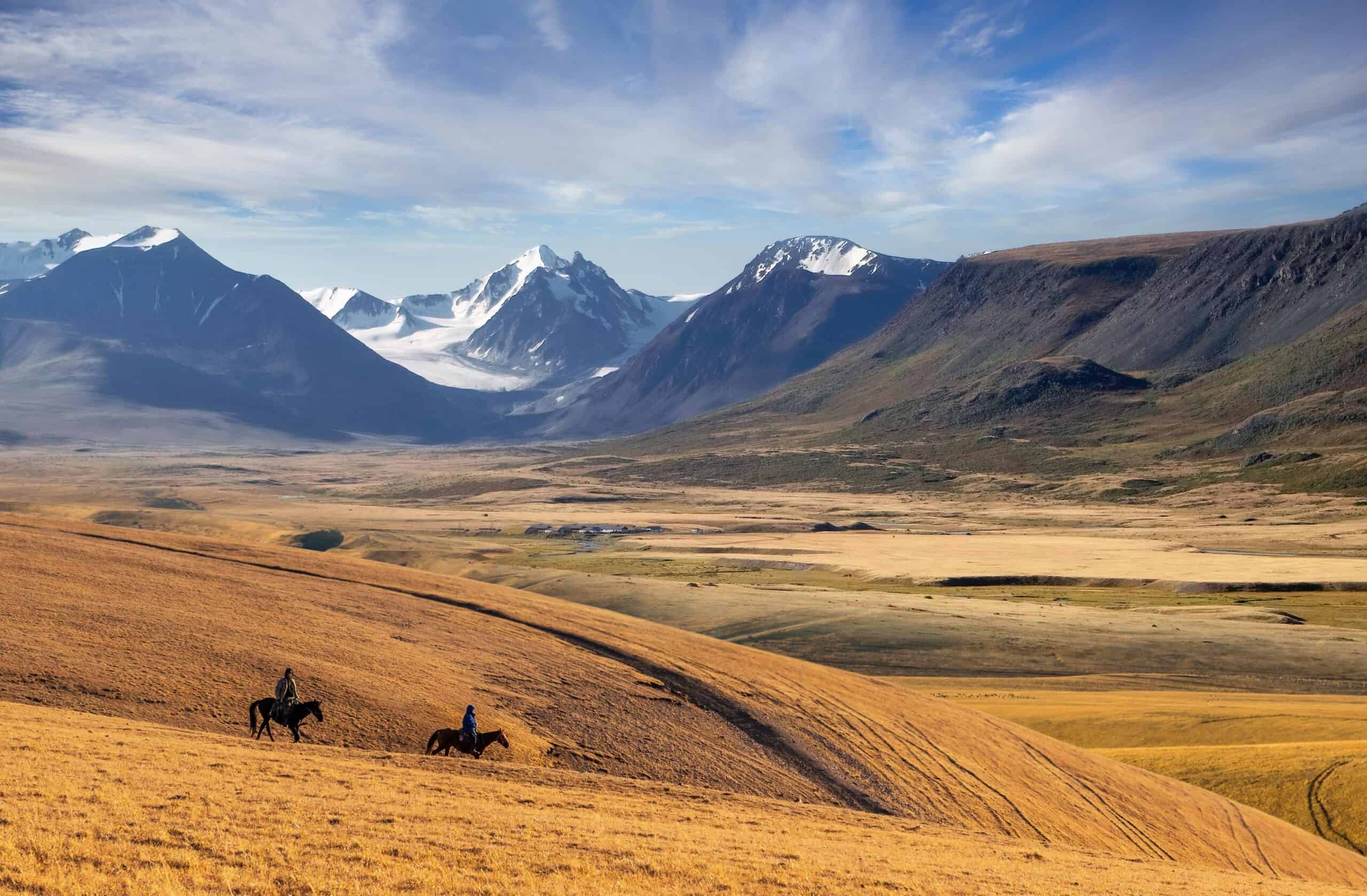
- Population density in 2022: 19 people per sq. mile
- Total population: 19,621,972 (63rd most of 195 countries)
- Total land area: 1,042,360 sq. miles (9th largest of 195 countries)
- Population by community type: 58.0% urban; 42.0% rural
- Gross domestic product in 2022: $225.5 billion ($11,492 per capita)
- Total fertility rate in 2021: Avg. of 3.3 children per woman over lifetime
10. Botswana
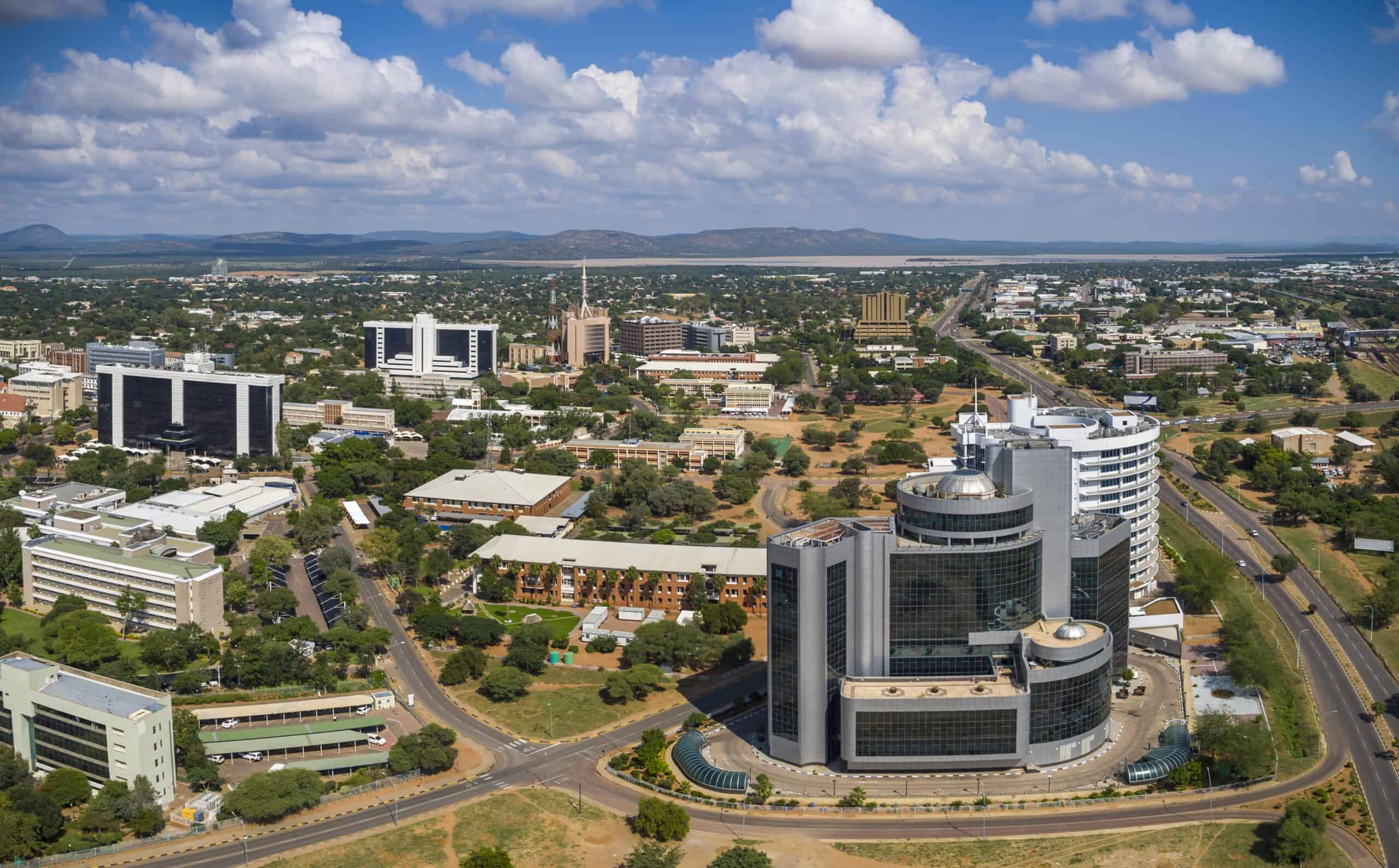
- Population density in 2022: 12 people per sq. mile
- Total population: 2,630,296 (139th most of 195 countries)
- Total land area: 218,816 sq. miles (47th largest of 195 countries)
- Population by community type: 72.2% urban; 27.8% rural
- Gross domestic product in 2022: $20.4 billion ($7,739 per capita)
- Total fertility rate in 2021: Avg. of 2.8 children per woman over lifetime
9. Mauritania

- Population density in 2022: 12 people per sq. mile
- Total population: 4,736,139 (123rd most of 195 countries)
- Total land area: 397,955 sq. miles (28th largest of 195 countries)
- Population by community type: 56.9% urban; 43.1% rural
- Gross domestic product in 2022: $9.8 billion ($2,065 per capita)
- Total fertility rate in 2021: Avg. of 4.4 children per woman over lifetime
8. Canada
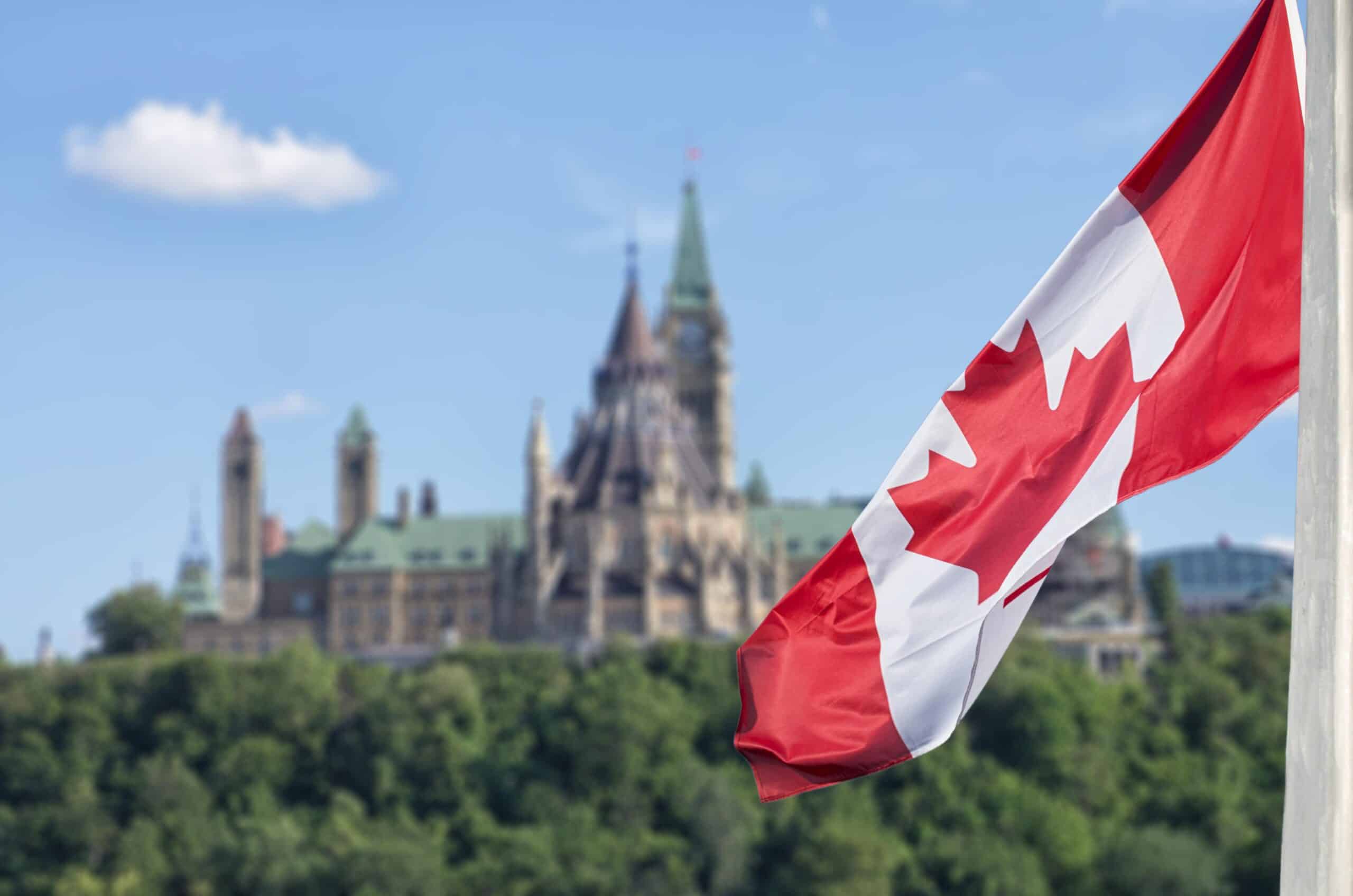
- Population density in 2022: 11 people per sq. mile
- Total population: 38,929,902 (37th most of 195 countries)
- Total land area: 3,393,336 sq. miles (4th largest of 195 countries)
- Population by community type: 81.8% urban; 18.2% rural
- Gross domestic product in 2022: $2.2 trillion ($55,522 per capita)
- Total fertility rate in 2021: Avg. of 1.4 children per woman over lifetime
7. Guyana
- Population density in 2022: 11 people per sq. mile
- Total population: 808,726 (160th most of 195 countries)
- Total land area: 76,004 sq. miles (84th largest of 195 countries)
- Population by community type: 27.0% urban; 73.0% rural
- Gross domestic product in 2022: $14.7 billion ($18,199 per capita)
- Total fertility rate in 2021: Avg. of 2.4 children per woman over lifetime
6. Suriname
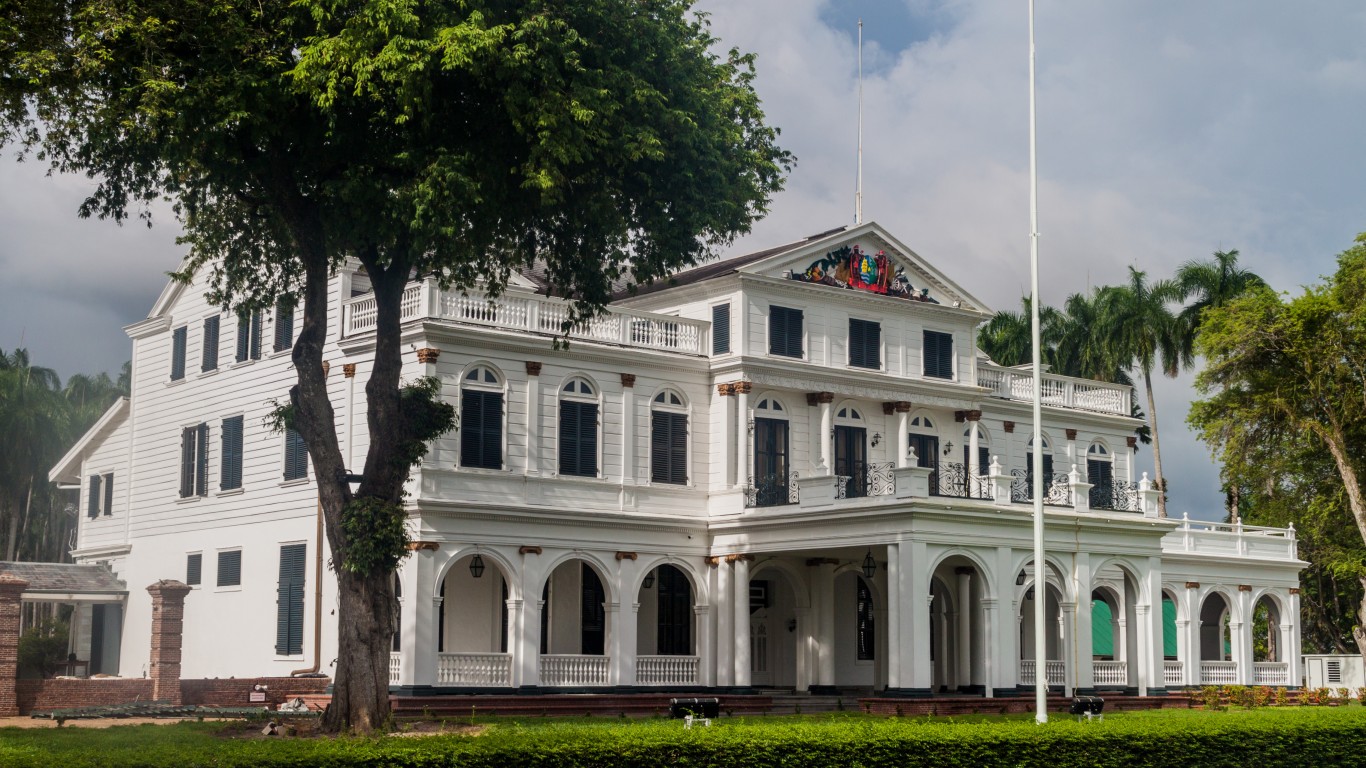
- Population density in 2022: 10 people per sq. mile
- Total population: 618,040 (164th most of 195 countries)
- Total land area: 60,232 sq. miles (90th largest of 195 countries)
- Population by community type: 66.3% urban; 33.7% rural
- Gross domestic product in 2022: $3.6 billion ($5,859 per capita)
- Total fertility rate in 2021: Avg. of 2.3 children per woman over lifetime
5. Libya

- Population density in 2022: 10 people per sq. mile
- Total population: 6,812,341 (105th most of 195 countries)
- Total land area: 679,362 sq. miles (16th largest of 195 countries)
- Population by community type: 81.3% urban; 18.7% rural
- Gross domestic product in 2022: $45.8 billion ($6,716 per capita)
- Total fertility rate in 2021: Avg. of 2.5 children per woman over lifetime
4. Iceland
- Population density in 2022: 10 people per sq. mile
- Total population: 382,003 (172nd most of 195 countries)
- Total land area: 38,931 sq. miles (104th largest of 195 countries)
- Population by community type: 94.0% urban; 6.0% rural
- Gross domestic product in 2022: $28.1 billion ($73,467 per capita)
- Total fertility rate in 2021: Avg. of 1.8 children per woman over lifetime
3. Australia
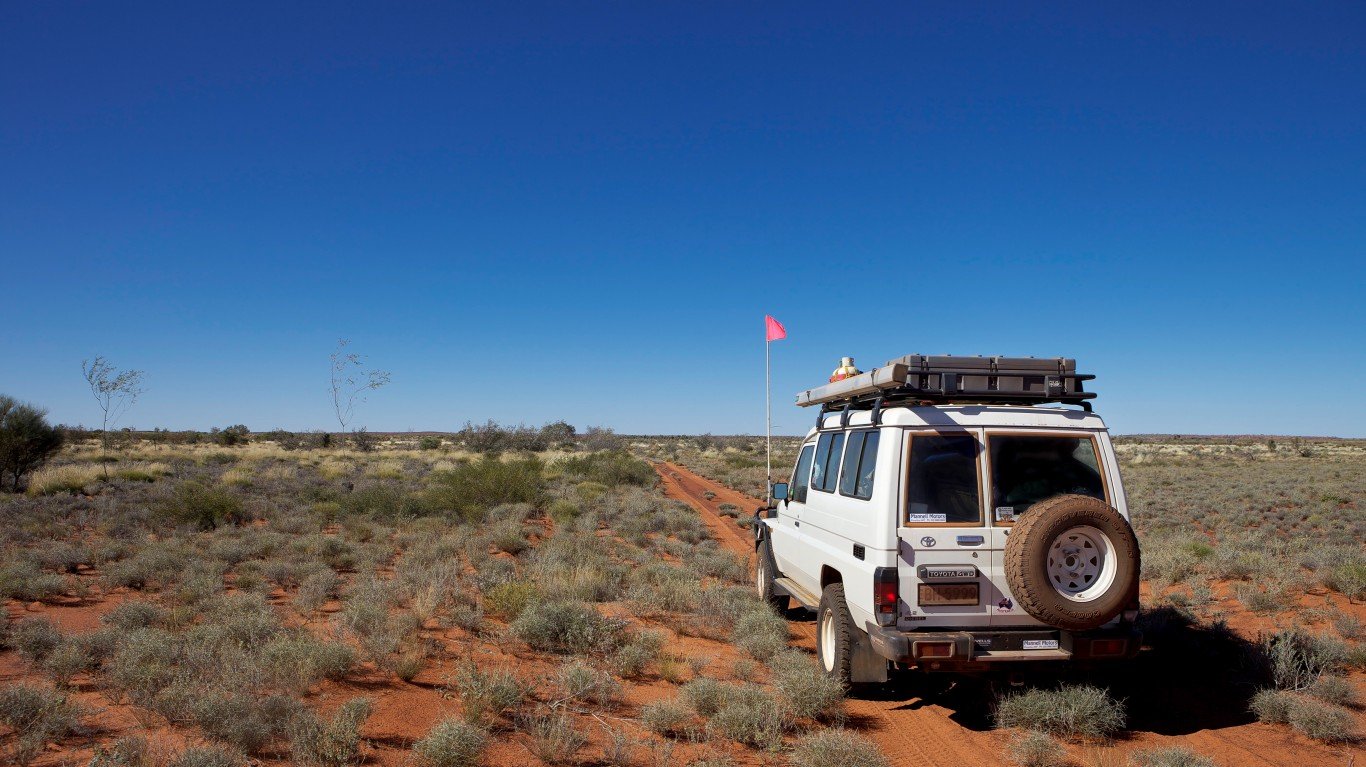
- Population density in 2022: 9 people per sq. mile
- Total population: 26,005,540 (56th most of 195 countries)
- Total land area: 2,969,906 sq. miles (6th largest of 195 countries)
- Population by community type: 86.5% urban; 13.5% rural
- Gross domestic product in 2022: $1.7 trillion ($65,100 per capita)
- Total fertility rate in 2021: Avg. of 1.7 children per woman over lifetime
2. Namibia
- Population density in 2022: 8 people per sq. mile
- Total population: 2,567,012 (140th most of 195 countries)
- Total land area: 317,874 sq. miles (33rd largest of 195 countries)
- Population by community type: 54.0% urban; 46.0% rural
- Gross domestic product in 2022: $12.9 billion ($5,031 per capita)
- Total fertility rate in 2021: Avg. of 3.3 children per woman over lifetime
1. Mongolia

- Population density in 2022: 6 people per sq. mile
- Total population: 3,398,366 (131st most of 195 countries)
- Total land area: 601,357 sq. miles (18th largest of 195 countries)
- Population by community type: 68.9% urban; 31.1% rural
- Gross domestic product in 2022: $17.1 billion ($5,046 per capita)
- Total fertility rate in 2021: Avg. of 2.8 children per woman over lifetime
Smart Investors Are Quietly Loading Up on These “Dividend Legends”
If you want your portfolio to pay you cash like clockwork, it’s time to stop blindly following conventional wisdom like relying on Dividend Aristocrats. There’s a better option, and we want to show you. We’re offering a brand-new report on 2 stocks we believe offer the rare combination of a high dividend yield and significant stock appreciation upside. If you’re tired of feeling one step behind in this market, this free report is a must-read for you.
Click here to download your FREE copy of “2 Dividend Legends to Hold Forever” and start improving your portfolio today.
Thank you for reading! Have some feedback for us?
Contact the 24/7 Wall St. editorial team.



